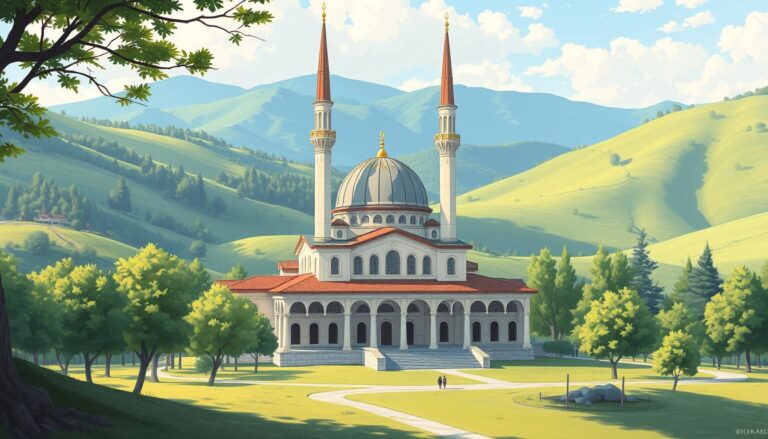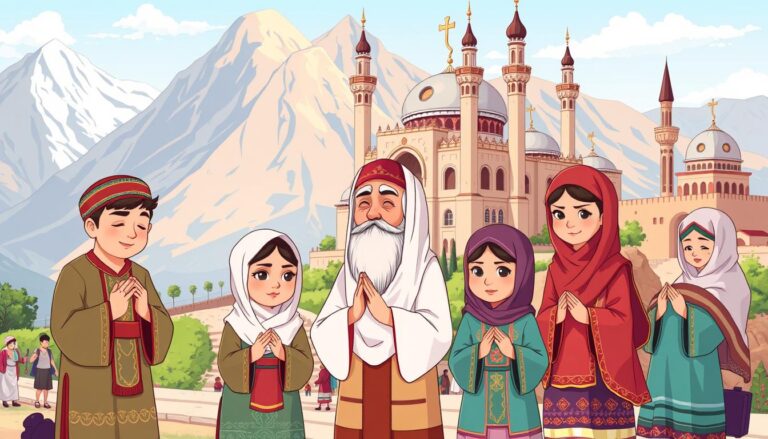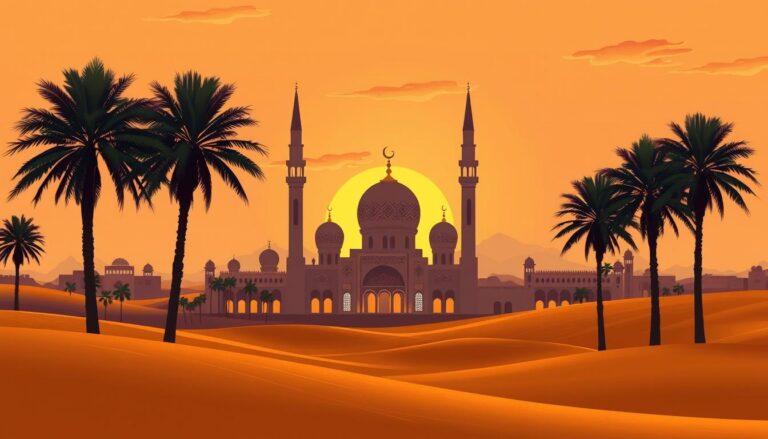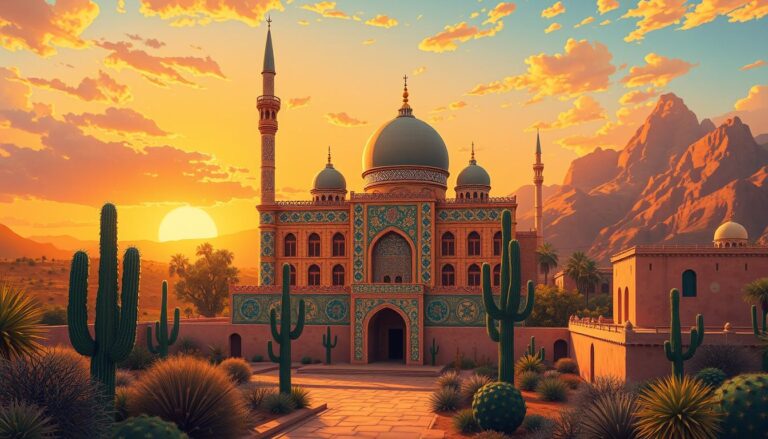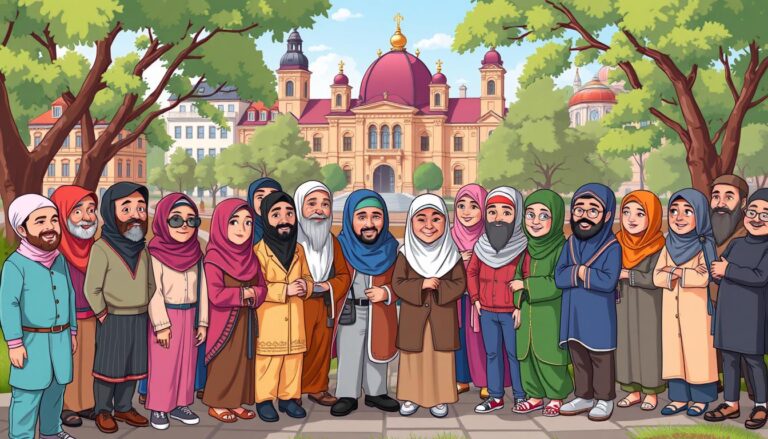Islam in the Philippines
Approximately 6.4% of the Philippines’ population of over 114.6 million are Muslim, making Islam the second-largest religion in the country. This religious minority has played a significant role in shaping the cultural and historical landscape of the Philippines, with a legacy that dates back to the 14th century. The arrival of Muslim traders, missionaries, and the establishment of Muslim sultanates have left an indelible mark on Philippine society, contributing to the nation’s diverse religious and ethnic tapestry.
Key Takeaways
- Islam is the second-largest religion in the Philippines, accounting for approximately 6.4% of the total population.
- The religion first arrived in the Philippines in the 14th century, brought by Muslim Malay and Arab merchants and Yemeni missionaries.
- The early spread of Islam led to the formation of Muslim sultanates in parts of Mindanao and the Sulu Archipelago.
- Islam has become deeply integrated into the cultural fabric of the Philippines, with Muslim communities contributing significantly to the country’s arts, literature, and cuisine.
- The Bangsamoro Autonomous Region in Muslim Mindanao (BARMM) has a Muslim majority population, reflecting the strong presence of Islam in the region.
Introduction to Islam in the Philippines
The history of Islam in the Philippines is deeply rooted, dating back to the 14th century. This spiritual tradition first reached the archipelago through the arrival of Muslim traders and missionaries from the Malay Archipelago and the Middle East. These early influences paved the way for the establishment of several prominent Muslim sultanates, such as the Sultanate of Maguindanao, Sultanate of Sulu, and Sultanate of Lanao, which played a pivotal role in the subsequent spread of Islamic faith throughout the southern regions of the Philippines.
Historical Origins and Early Influences
The first Islamic missionary is believed to have reached the Sulu Archipelago and Jolo in 1380, and the Sheik Karimal Makdum Mosque, established on Simunul, is considered the oldest mosque in the Philippines. Over the centuries, Islam’s influence in the Philippines grew through a combination of trade, preaching, and even resistance against the Spanish and American colonial powers.
Diversity of Muslim Communities and Cultures
Today, the Muslim population in the Philippines is remarkably diverse, comprising various ethnic groups, including the Moro, Tausug, Magindanao, Maranao, and others. Each of these communities has its own distinct cultural traditions, practices, and heritage, reflecting the rich tapestry of Islamic history in the Philippines and the Muslim communities in the Philippines. This diversity is a testament to the resilience and adaptability of the diversity of Muslim Filipinos over the centuries.
“Islam reached the Philippines in the 14th century, with the arrival of Muslim traders and missionaries from the Malay Archipelago and the Middle East. These early influences led to the establishment of several prominent Muslim sultanates that played a significant role in the spread of Islamic faith throughout the southern regions of the country.”
Islam in the Philippines: A Historical Perspective
The arrival of Muslim traders and missionaries in the 14th century marked a pivotal moment in the arrival of Islam in the Philippines. These early contacts facilitated the formation of several influential Muslim sultanates in the southern regions of the country, such as the Sultanate of Maguindanao, Sultanate of Sulu, and Sultanate of Lanao. These Muslim kingdoms played a crucial role in the historical spread of Islam throughout the Philippines, paving the way for its continued influence on the nation’s cultural and social landscape.
Establishment of Muslim Sultanates
The establishment of these Muslim sultanates in the Philippines was a significant chapter in the history of Islam’s integration into the country. These powerful kingdoms, which emerged in the 14th and 15th centuries, were instrumental in propagating the religion and its teachings across the southern regions. The Sultanate of Maguindanao, Sultanate of Sulu, and Sultanate of Lanao were among the most prominent of these Islamic polities, exerting their influence and leaving a lasting impact on the Philippine archipelago.
“There are more than two million Muslims in the Philippine South with all the attributes of Philippine citizenship.”
The struggle of the Muslims in the South against any form of Western dominance is often interpreted as an expression of their patriotism and resistance to outside interference. This resistance to Spanish and other colonial powers was an integral part of the wider Malaysian struggle against Western imperialism in the region.
Despite the historical significance of these Muslim sultanates, some textbooks on Philippine history have tended to consider the Islamic South as insignificant chapters in the development of the national community. This is largely due to the fact that the majority of the historical data on the subject originates from Spanish sources, which often portrayed the Muslims in a negative light.
The Spread of Islam in the Philippines
The spread of Islam in the Philippines was a gradual process that occurred over several centuries. Beginning in the 7th century, Islam started its expansion towards eastern regions through trade on the maritime Silk Roads. By the 13th century, the adoption of Islam amongst the royalty in Sumatra can be traced back to tombstones engraved with the Islamic year date of Sumatran Kings. Similarly, archaeological records indicate the presence of Muslims in the Philippines before the 10th century.
The arrival of Muslim traders and merchants in the 14th century further facilitated the Islamization of the local populations in the southern regions of the Philippines, particularly in Mindanao and the Sulu Archipelago. The establishment of influential Muslim sultanates, such as Maguindanao and Sulu, played a crucial role in the spread of Islam, leading to the integration of Islamic practices and traditions into the cultural fabric of these communities.
According to the latest statistics, the spread of Islam in the Philippines has continued to this day. In 2020, the Philippine Statistics Authority found that 6.4% (6,981,710) of Filipinos were Muslims, increased from 6.0% (6,064,744) in 2015. The National Commission on Muslim Filipinos (NCMF) estimates Muslims constitute 11% of the total population in the Philippines, with the Bangsamoro region being predominantly Muslim, with 91% of its 4.9 million inhabitants adhering to Islam.
“Islam has been present in the Philippines since the 14th century when it was introduced by Indian, Malay, and Javanese merchants, as well as Arab missionaries from the Malay Archipelago.”
The Islamization of the Philippines has been a gradual and peaceful process, with Muslim merchants and missionaries blending their faith with the existing cultural and religious influences in the region. Despite external challenges and exploitation, the Muslim population in the Philippines has maintained their faith in Islam, using Islamic awareness as a mobilizing factor for unity and a strong affinity with the global Muslim community (ummah).
Prominent Muslim Ethnic Groups in the Philippines
The Muslim population in the Philippines is composed of diverse ethnic groups, with the Moro people being the most prominent. The Moro are an indigenous ethnic group native to the southern regions of the country, particularly in Mindanao and the Sulu Archipelago, and have a long history of practicing Islam.
The Moro People and Their Cultural Traditions
The Moro people have a rich cultural heritage that is deeply intertwined with their religious beliefs. They are known for their traditional arts, literature, and cuisine, which reflect their unique identity and way of life. For instance, the Moro are skilled in creating intricate textile designs, such as the Inaul weaving, and producing masterful works of art, including Okir wood carvings and Kris swords.
In addition to the Moro, other significant Muslim ethnic groups in the Philippines include the Tausug, Magindanao, and Maranao, each with their own distinct cultural traditions. These groups have played a vital role in shaping the diverse tapestry of the country’s Muslim communities.
“The Moro people have a rich cultural heritage that is deeply intertwined with their religious beliefs. They are known for their traditional arts, literature, and cuisine, which reflect their unique identity and way of life.”
The cultural traditions of the Moro and other Muslim ethnic groups in the Philippines are a testament to the enduring spirit of these communities, who have maintained their cultural identity despite centuries of external influence and challenges.
Islamic Practices and Institutions
The Muslim communities in the Philippines have established a vibrant network of Islamic institutions and practices that reflect their rich religious and cultural heritage. Mosques and Islamic centers serve as the heart of these communities, providing spaces for worship, education, and social gatherings.
Mosques and Islamic Centers
Mosques are the focal points of Islamic life in the Philippines. These sacred structures not only host daily prayers and Friday congregations but also serve as hubs for various community activities. Many mosques also house Islamic schools, known as madrasas, where children and adults can study the Quran, Islamic jurisprudence, and other religious subjects. The Islamic practices in the Philippines are deeply rooted in these mosques and centers, which play a vital role in preserving the faith and traditions of the Filipino Muslim population.
Shariah Law and Its Application
The Shariah law in the Philippines has been integrated, to some degree, within the country’s legal framework, particularly in the Bangsamoro region. The Shafi’i school of Sunni Islam is the predominant Islamic tradition among Filipino Muslims, with the Hanbali (Athari) school also being present in smaller numbers. The application of Shariah law covers various aspects of daily life, including family law, inheritance, and dispute resolution. However, the extent and implementation of Shariah law vary across different regions and communities within the Philippines.
The role of mosques and Islamic institutions in the Philippines is crucial in maintaining the religious identity and cultural practices of the Muslim population. These institutions serve as the cornerstones of the Filipino Muslim community, providing a space for spiritual growth, community engagement, and the preservation of Islamic traditions.
Islam in the Philippines: Challenges and Integration
While Islam has been firmly established in the Philippines for centuries, the community has faced various challenges facing Islam in the Philippines. Historical tensions and conflicts, particularly in the Mindanao region, have created political and social divides between Muslim and non-Muslim Filipinos. However, there have been ongoing efforts to promote greater understanding, dialogue, and cooperation between the different religious and ethnic communities, with the aim of fostering a more harmonious and inclusive society for the integration of Muslim Filipinos.
One of the key challenges facing the Muslim community in the Philippines is the lack of recognition and representation within the predominantly Catholic nation. According to the Philippine Statistics Authority, Muslims comprise only 6% of the national population. This minority status has made it difficult for the Muslim community to assert its cultural and religious identity, leading to feelings of marginalization and alienation.
The ALIVE Program, which stands for Arabic Language and Islamic Values Education, has been a significant initiative aimed at addressing this issue. Implemented through a series of consultations and efforts by the government and Muslim intellectuals, the program seeks to provide appropriate and relevant educational opportunities for Muslim Filipinos within their accepted cultures, customs, traditions, and interests. However, the program has faced implementation challenges, including the scarcity of learning spaces and the need for enhancing the pedagogical competence of Asatidz or Madrasah teachers.
“The implementation challenges of the ALIVE Program highlighted the scarcity of learning spaces, the need for enhancement of pedagogical competence among Asatidz or Madrasah teachers, and cultural variances among Muslims, especially in non-Muslim communities.”
Despite these challenges, there have been ongoing efforts to promote greater integration of Muslim Filipinos into the broader Philippine society. The government, through initiatives like the Madrasah Education Program (MEP) and the ALIVE Program, has sought to bridge the gap between the Muslim and non-Muslim communities, while respecting the cultural and religious diversity of the country.
Moving forward, the key to addressing the challenges facing Islam in the Philippines lies in fostering greater understanding, dialogue, and collaboration between all stakeholders. By embracing the rich cultural heritage of the Muslim community and promoting inclusive policies, the Philippines can work towards a more harmonious and integrated society that celebrates its diversity.
Contributions of Muslims to Philippine Culture
The Muslim communities in the Philippines have made significant contributions to the country’s rich cultural heritage. From the realm of arts and literature to the vibrant culinary traditions, the influence of Islamic culture is deeply embedded in the Philippines.
Arts, Literature, and Cuisine
In the realm of arts and literature, Filipino Muslims have produced a tapestry of traditional artforms, such as intricate textiles, stunning metalwork, and captivating poetry. These creative expressions reflect the unique blend of Muslim and indigenous influences, showcasing the diversity of Muslim contributions to Philippine culture.
The culinary traditions of the Philippines also bear the mark of the country’s Muslim population. Muslim cuisine in the Philippines is characterized by a distinct blend of flavors, ingredients, and preparation methods that have been passed down through generations. Dishes like pinapaitan and tiyula itum are just a few examples of the Islamic influence on Philippine arts and literature.
“The Muslim heritage in the Philippines is a testament to the rich cultural tapestry that has been woven throughout the country’s history.”
From the vibrant artistry to the tantalizing flavors, the contributions of the Muslim community have undoubtedly left an indelible mark on the Philippine culture. Their artistic and culinary legacies continue to captivate and inspire, serving as a testament to the diversity and richness that defines the nation.
Islam in the Philippines
Islam has been an integral part of the Philippines for centuries, shaping the country’s cultural, social, and political landscape. With a population of around 6.4% as of 2020, Muslim Filipinos have established vibrant communities across the archipelago, particularly in the southern regions of Mindanao and the Sulu Archipelago. The Muslim presence in the Philippines is characterized by its diversity, with various ethnic groups and traditions coexisting and contributing to the nation’s rich cultural heritage.
The Moro people, the largest Muslim ethnic group in the Philippines, are predominantly located in Mindanao and the surrounding islands. They have a long history of Islamic influence, dating back to the arrival of Muslim traders and missionaries in the 13th century. Over the centuries, the Moro communities have developed their own unique cultural practices, traditions, and language, while maintaining their strong Islamic faith.
Despite the significant presence of Islam in the Philippines, the country has faced its share of challenges in integrating and accommodating the Muslim minority. Efforts towards peace and reconciliation have been ongoing, with the establishment of the Bangsamoro Autonomous Region of Muslim Mindanao (BARMM) in 2019 providing a framework for greater autonomy and self-governance for the region.
“Islam has been an integral part of the Philippines for centuries, shaping the country’s cultural, social, and political landscape.”
The future of Islam in the Philippines remains both promising and complex. As the country continues to navigate the dynamics of religious diversity and regional autonomy, it is crucial to promote understanding and harmony between Muslim Filipinos and the wider Philippine society. By embracing the rich Islamic heritage and the contributions of Muslim Filipinos, the Philippines can foster a more inclusive and equitable future for all its citizens.
The Future of Islam in the Philippines
As the Philippines continues to evolve, the future of Islam in the country remains a topic of great interest and importance. The Muslim population in Southeast-East Asia is expected to grow from 257.7 million in 2010 to 307.3 million in 2030, reflecting the increasing presence of Islam in the region.
Efforts Towards Peace and Reconciliation
Ongoing efforts to promote peace and reconciliation between Muslim and non-Muslim communities, particularly in the Mindanao region, are crucial for fostering a more inclusive and harmonious society. The largest militant group, MILF, has been striving for comprehensive autonomy rather than outright independence, signaling a shift towards a more measured approach.
However, concerns have been rising about the influence of ISIS in the Philippines, with an estimated 200 Filipino nationals reported to have infiltrated Iraq for training with the terrorist organization. The creation of a centralized database to track citizens suspected of joining ISIS is a step in the right direction, but continued vigilance and cooperation between authorities and local communities will be essential.
Promoting Understanding and Harmony
Initiatives aimed at increasing mutual understanding and respect between different religious and ethnic groups can help to bridge the divides and strengthen the social fabric of the nation. By fostering a culture of tolerance and inclusivity, the Philippines can unlock the full potential of its diverse population and ensure a future where the future of Islam in the Philippines, peace and reconciliation efforts, and promoting religious harmony are seamlessly integrated.
“The path to a peaceful and harmonious future for the Philippines lies in embracing the diversity of its people and building bridges of understanding between all communities.”
Conclusion
The story of Islam in the Philippines is one of resilience, adaptation, and ongoing influence. From the arrival of Muslim traders and missionaries in the 14th century to the present-day integration of Islamic traditions and institutions, Islam has left an indelible mark on the country’s cultural, social, and political landscape. Despite being a minority religious community, making up 6.4% of the Filipino population, Muslims have played a significant role in shaping the nation’s diverse religious tapestry.
As the Philippines continues to navigate the challenges of religious coexistence and diversity, the preservation and celebration of the rich Islamic heritage will be crucial for promoting understanding, harmony, and a more inclusive national identity. The unique legal status of Islam in the Philippines, with institutions like the National Commission for Muslim Filipinos and sharia court jurisdiction, underscores the enduring influence of this faith in the country.
Moving forward, the continued efforts towards peace and reconciliation, along with the promotion of mutual understanding and respect, will be instrumental in ensuring that the story of Islam in the Philippines remains one of resilience, adaptation, and enduring impact on the nation’s cultural fabric.
Source Links
- Philippines – United States Department of State
- Moro Muslims in the Philippines – Minority Rights Group
- Islam in the Philippines
- Islam in the Philippines
- Did you know?: The Spread of Islam in Southeast Asia through the Trade Routes
- Moro people
- No title found
- Islam and Muslims in the Philippines
- 2012 Report on International Religious Freedom – Philippines | Refworld
- The Islamic State in the Philippines: A Looming Shadow in Southeast Asia? – Combating Terrorism Center at West Point
- Region: Asia-Pacific
- Philippines



